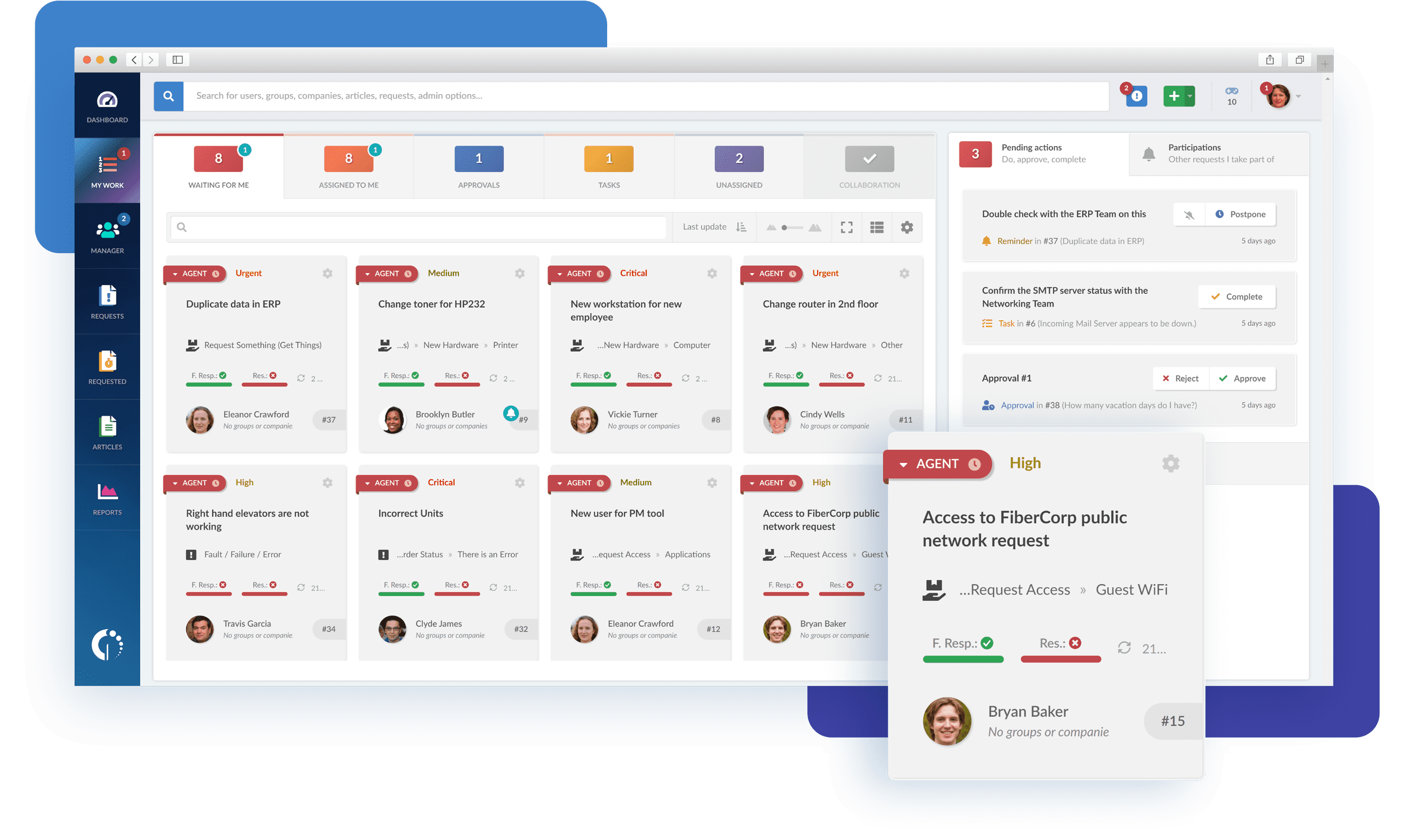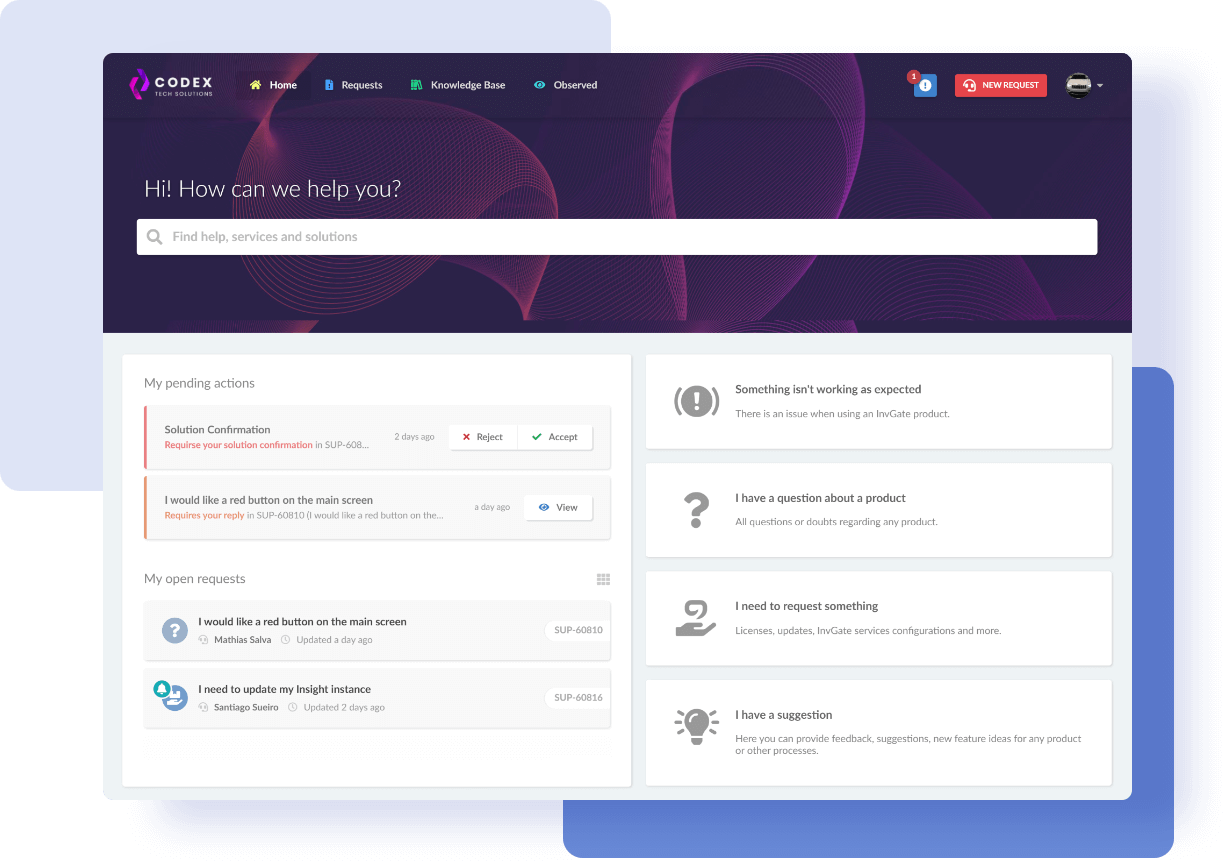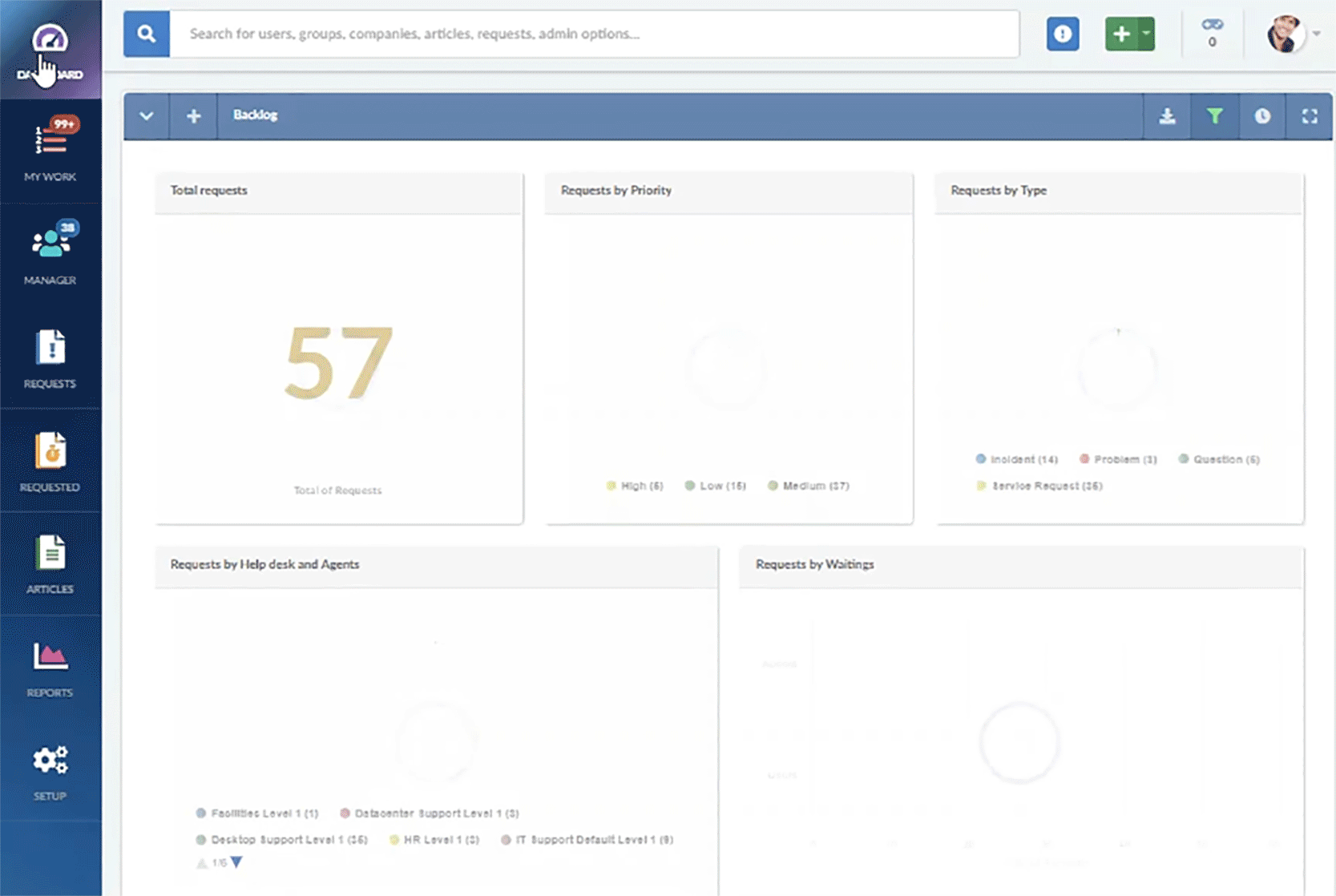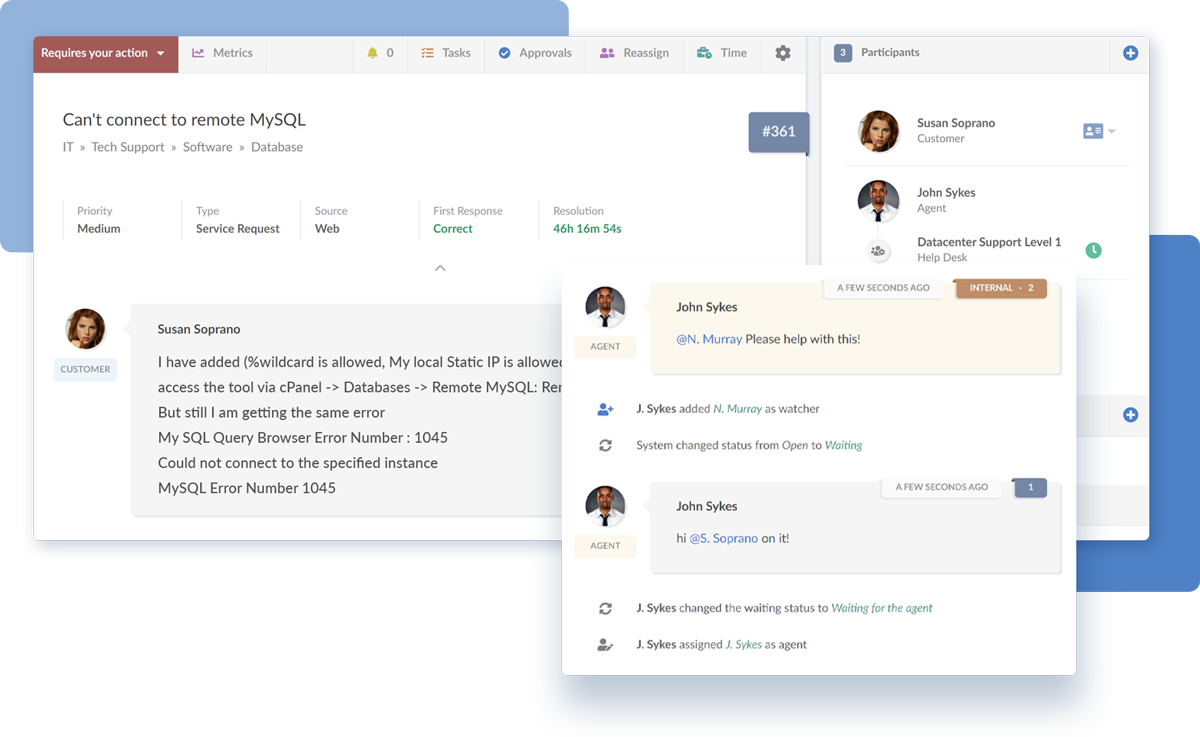Choosing the right IT Service Management (ITSM) solution is a crucial decision that directly impacts the efficiency and effectiveness of your organization's operations and service delivery. When faced with prominent contenders like Aranda Service Management vs. Jira Service Management, it becomes vital to thoroughly evaluate their features, capabilities, and suitability for your specific requirements. But what if there’s an alternative that could offer even more value?
In this post, we’ll compare Aranda Service Management and Jira Service Management to help you understand their strengths and weaknesses. We’ll also introduce InvGate Service Management, a robust service desk software that can help you streamline your operations and focus on digital transformation, giving you a great opportunity to elevate your IT capabilities.
Let's dive into this ITSM tools comparison and discover the ITSM software that will drive your organization toward operational excellence.

Table of contents
- TL;DR
- What is Aranda Service Management?
- What is Jira Service Management?
- Considering InvGate Service Management as an ITSM solution alternative
TL;DR
- Aranda Service Management offers a unified web console and flexible installation options while ensuring rapid implementation with default configurations. It also provides Spanish support in Latin America. Nonetheless, its absence of reviews on major platforms leaves specific user criticism unidentified.
- Users highlight Jira Service Management's sprint planning and task assignment capabilities, as well as its ticketing system and end-user portal. However, they dislike the migration process, its limitations in reporting, a steep learning curve, and the reliance on additional plugins.
- InvGate Service Management, on the other hand, provides a streamlined ITSM setup, flexible deployment, robust ticketing and incident management, and self-service capabilities, emphasizing cost-effectiveness and innovation.
We tried to be as thorough as possible, but if you don't have enough time to read it through and through, here's (another) TL;DR: InvGate Service Management can do everything we say here, and you can test it right away for free for 30 days.
What buyers look for in an ITSM solution
When evaluating options for managing IT services, potential buyers focus on specific features that meet their organization's requirements. Understanding these desired features is crucial for making well-informed decisions.
Let's explore the main factors prospective buyers typically consider when comparing IT Service Management tools.
- Customization and flexibility: Buyers look for software solutions that offer customization options, allowing them to adapt the platform to their business needs. This flexibility ensures that the software aligns with their unique workflows and processes, enhancing user satisfaction and effectiveness.
- Efficient IT Asset Management: Users prioritize software that offers robust capabilities for managing IT assets, maintaining accurate inventories, and optimizing resource utilization within their organizations.
- Ticket Management: Buyers acknowledge the importance of a comprehensive system for managing customer inquiries and support requests in help desk software. This feature enables efficient tracking, assignment, and resolution of tickets.
- User experience and interface: Buyers prioritize ease of use and interface design. They prefer a user-friendly platform with an intuitive interface that encourages user adoption and improves productivity. Mobile accessibility is also crucial, especially for organizations with remote or mobile workforces.
- Support automation and Workflow Management: Buyers actively seek software solutions that provide automation capabilities to streamline routine tasks such as ticket routing, approvals, and escalations.
- Scalability: Organizations with evolving needs prioritize solutions that can accommodate their growth and allow for customization. The solution should enable the creation of custom fields, workflows, and extensions/plugins, enabling them to tailor the software to their unique business requirements.
- Optimized IT service catalog: Organizations often require a streamlined IT service catalog that provides a centralized platform for users to request specific IT services or resources.
- Self-service portal and knowledge base: Buyers highly value a self-service portal that empowers end-users to independently resolve common issues and access relevant information without direct assistance.
- Insightful reporting: Buyers look for help desk software with powerful reporting tools, such as dashboards and reports, providing valuable insights into their IT operations and performance. This data-driven approach supports informed decision-making and continuous service improvement.
- Seamless integration capabilities: Integration with other systems and applications is a crucial requirement for buyers, ensuring smooth data flow and process automation. Integrating with existing tools (particularly ITAM solutions) and platforms is highly valued for improved efficiency and a unified user experience.
- Pricing and support: Buyers consider the solution's cost-effectiveness, including licensing models, subscription plans, and additional costs for features or users. Reliable customer support, comprehensive documentation, and accessible training resources also influence the decision-making process.
- ITIL compliance: Many organizations prioritize solutions that adhere to ITIL best practices. Buyers may focus on solutions that support ITIL processes such as Incident Management, Problem Management, Change Management, and Asset Management.
What is Aranda Service Management?
Aranda Service Management is the primary software solution offered by Aranda Software, a Colombian company specializing in IT service and infrastructure management. This comprehensive software is specifically designed to assist businesses in efficiently handling various processes and providing support for different types of cases. With Aranda Service Management, businesses can effectively manage requests, incidents, problems, and changes, all through a centralized console.
Alongside Aranda Service Management, Aranda Software offers a range of software products that adhere to the best practices of ITIL. Among these products is Aranda Asset Management, which focuses on delivering value to businesses in the Latin American region. With a strong local presence in 10 Latin American countries, Aranda Software provides flexible licensing options, including Cloud, On-premise, Hybrid, and SaaS models.
What users like about Aranda Service Management
The following benefits are sourced from the company's website as of the time of writing. However, there are no reviews available on popular platforms like Gartner, G2, or Capterra, which could provide additional insights from user perspectives.
- Design and user-friendliness: The software offers an intuitive interface, easy configuration, fast loading times, and overall user-friendliness, contributing to a positive user experience.
- Options for on-premise/cloud deployment: Users can choose between different installation options based on their infrastructure needs and organizational preferences, whether it's an on-premise or cloud-based deployment.
- Unified web console: The platform provides a unified web console that can be accessed through a fully web-based platform. This integrated and centralized suite eliminates the need to install a console on individual computers.
- Efficient implementation: The platform aims to expedite the implementation process by offering default configurations, templates, and models. These resources are readily available to accelerate the configuration process and ensure a quick setup.
- Inclusion of Aranda Query Manager: Users with an ADM package license can benefit from the Aranda Query Manager feature. This advanced reporting solution provides a customizable dashboard, enhancing the software's reporting capabilities.
What users don’t like about Aranda Service Management
As there are no reviews or feedback on platforms such as Gartner, G2, or Capterra, it is challenging to pinpoint specific complaints or criticisms about Aranda Service Management. Without user perspectives and experiences shared on these platforms, we don't have access to negative aspects to highlight.
What’s Aranda Service Management’s argument over Jira Service Management?
As we mentioned, due to the absence of detailed user feedback or reviews for Aranda Service Management, we can't make a conclusive argument about its superiority over Jira Service Management at the moment. However, based on the listed benefits and strengths highlighted by Aranda Service Management, there are potential areas where it could present advantages over Jira Service Management.
These areas we think are worth considering:
- Design and user-friendliness: Aranda Service Management offers an intuitive interface, easy configuration, and overall user-friendliness.
- Options for on-premise/cloud deployment: Users have the flexibility to choose between on-premise or cloud-based deployment based on their infrastructure needs and organizational preferences.
- Localized support in Spanish: The availability of a specialized and certified support team in Latin America offers assistance to users in their preferred language.
What is Jira Service Management?

Jira Service Management, a product created by Atlassian, is a specialized platform crafted for IT Service Management. It provides organizations with an effective solution to streamline their service desk operations. Through its robust features and user-friendly interface, Jira Service Management empowers businesses to optimize service delivery and improve customer satisfaction. Currently, it offers a cloud-based service option, allowing organizations to leverage the advantages of cloud computing for their Service Management needs.
Atlassian, the company behind Jira, was established in 2002 by Mike Cannon-Brookes and Scott Farquhar in Sydney, Australia. Since its inception, the company has experienced substantial growth and expanded its global presence by establishing offices in various countries, including the United States, Netherlands, Japan, and the Philippines.
Atlassian specializes in developing software and tools tailored to developers and project managers. Their extensive product portfolio includes well-known offerings like Confluence, Bitbucket, and Trello, which have gained wide recognition in the industry. These versatile tools cater to various requirements, covering project management, issue tracking, content collaboration, code management, and team facilitation.
Jira Service Management uses a licensing model where organizations pay for each agent who manages service requests, with no limit on the number of customers who can submit requests. Jira has a free plan that allows up to three agents to try out the service with limited features to evaluate the software before upgrading to a paid plan. If you exceed the number of agents, you get a 7-day trial of Jira Service Management Cloud Standard or Premium.
What users like from Jira Service Management
Jira Service Management has received accolades from customers for its numerous positive attributes, as identified by reputable sources such as Gartner and G2. Here are some of the benefits that have been recognized.
- Detailed task details and filtering capabilities: Users value the platform's ability to provide comprehensive task information, offering a detailed understanding of each task. Additionally, Jira Service Management provides robust filtering capabilities, enabling users to search and organize tasks based on specific criteria.
- Efficient sprint planning and task assignment: Jira Service Management streamlines sprint planning and allows for easy task assignment, seamlessly integrating with collaboration platforms like Slack and Teams. The Kanban view centralizes task management, and the tagging function enables project-specific task organization.
- Intuitive interface: Users appreciate the user-friendly interface of Jira Service Management, which improves Incident and Request Management processes.
- Improved user portal for self-service: The platform offers an enhanced user portal that enhances the self-service experience and facilitates incident self-assessment. Users can also rate the overall process upon issue resolution, providing valuable feedback for continuous improvement and customer satisfaction.
- Ticketing system: The platform's ticketing system and customizable workflows simplify task management.
- Affordable pricing options: Jira Service Management offers a range of pricing options, including a free plan for up to 3 users with 2 GB storage. The cloud-hosted option provides a reasonable base price, making it accessible to organizations of various sizes.
What users don’t like about Jira Service Management
Despite its numerous strengths, Jira Service Management is not without customer concerns and dislikes regarding specific aspects of the platform. Through analysis conducted by reputable sources such as Gartner and G2, these dislikes stand out among users.
- Non-user-friendly interface: Compared to alternatives, some users find the platform less intuitive, especially for external customers interacting with the platform.
- Challenging migration process: Transitioning to Jira Projects can be complex and may require a separate user subscription.
- Lack and complexity of integrations: Users have noted a perceived lack of available integrations, requiring the development of custom integrations. Some users have also faced challenges when integrating Jira Service Management with certain tools.
- Need for additional plugins: Users have reported the need for extra plugins to access basic features and difficulties in achieving compliance with GDPR (General Data Protection Regulation).
- Difficult task tracking and reporting: Users have encountered difficulties in tracking multiple tasks, generating reports, and creating dashboards.
- Steep learning curve: Due to the platform's complexity and the need to learn and adapt to its functionalities, users may require assistance to become proficient in using the platform and its features.
- Difficulty working with Atlassian support: Users have expressed challenges when interacting with Atlassian support.
What’s Jira Service Management’s argument over Aranda Service Management?
Let's explore some key points that contribute to Jira Service Management's appeal over Aranda Service Management.
- Extensive marketplace and integrations: Jira Service Management benefits from the vast ecosystem of Atlassian products, including Jira Software, Confluence, and Bitbucket. Additionally, Jira Service Management has a robust marketplace offering numerous integrations and add-ons, enabling organizations to extend the platform's functionality and tailor it to their specific needs.
- Established user base and community support: Jira Service Management has a large user base and an active community of users who contribute to forums, provide resources, and share best practices. A thriving community allows users to seek guidance, share experiences, and benefit from the collective knowledge of Jira Service Management users worldwide.
- Agile Project Management Capabilities: Leveraging its roots in Jira Software, Jira Service Management provides strong Agile project management functionalities. It offers features such as Scrum and Kanban boards, Agile reporting, and sprint planning.
- Atlassian ecosystem benefits: Being part of the Atlassian ecosystem, Jira Service Management can take advantage of cross-product integration opportunities. Organizations using other Atlassian products can benefit from seamless collaboration and data synchronization, creating a unified experience across different areas of their operations.
- Customization and flexibility: Jira Service Management offers extensive customization options, enabling organizations to tailor the platform to their unique requirements. From configuring workflows and custom fields to creating automation rules and personalized dashboards, Jira Service Management provides the flexibility needed to adapt to diverse business processes and ITSM needs.
- Rich reporting and analytics capabilities: Jira Service Management provides comprehensive reporting and analytics features, allowing organizations to gain insights into their service performance, identify bottlenecks, and track key metrics.
- Deep ITSM functionality: Jira Service Management offers a wide range of ITSM features, including Incident Management, Problem Management, Change Management, and service catalog management. These functionalities, combined with its Agile project management capabilities, make Jira Service Management a versatile platform for organizations seeking comprehensive ITSM solutions.
Considering InvGate Service Management as an ITSM solution alternative

Aranda Service Management and Jira Service Management are popular choices, but with IT Service Management continuously evolving. That's why it's worth exploring options that may offer new or specialized features to better meet your organization's needs.
InvGate Service Management stands out as a strong alternative. Here’s a look at the features that make it a valuable option for meeting your ITSM requirements.
Simplified configuration and setup
InvGate Service Management simplifies the configuration and setup process with a user-friendly, no-code/low-code approach. This allows both novice and experienced users to implement the system without extensive technical expertise. With straightforward configuration options, organizations can get started quickly.
Exceptional user experience

InvGate Service Management prioritizes delivering an outstanding user experience through meticulous design and adherence to UI/UX best practices. Its intuitive interface promotes quick adoption, minimizes the need for extensive training, and ensures a user-friendly design that maximizes productivity.
Strong self-service capabilities

InvGate Service Management provides robust self-service functionalities, such as a user-friendly portal, an extensive IT service catalog, and a knowledge base. These features empower end-users to independently resolve common issues, access various IT services, and utilize self-help resources, thereby reducing the workload on IT staff.
Comprehensive reporting and analytics

InvGate Service Management provides extensive reporting and analytics functionalities, empowering organizations to gain valuable insights into their IT operations and performance. It also offers ready-to-use reports and customizable dashboards, enabling IT teams to analyze data, identify patterns, and make informed decisions to enhance their services.
Robust ticketing and Incident Management

InvGate Service Management offers powerful features that enable efficient tracking, collaboration, and resolution of tickets. It includes automated ticket routing, customizable workflows, and SLA Management, empowering IT teams to handle and prioritize incidents effectively.
Cost-effective
InvGate Service Management offers a comprehensive range of ITSM features at a competitive price, making it a cost-effective solution without compromising functionality. Compared to alternatives like Aranda Service Management and Jira Service Management, InvGate Service Management strikes a balance between cost and functionality.
Beyond IT: ESM extension
InvGate Service Management is built for IT Service Management (ITSM) and easily extends to Enterprise Service Management (ESM), supporting departments beyond IT. With InvGate, teams across your organization can streamline workflows, improve service delivery, and leverage digital tools for greater efficiency. InvGate enables smoother processes and more efficient digital transformation across your organization.
ITIL-certified
InvGate Service Management has achieved the prestigious ITIL4 certification from PeopleCert, as well as PINK Elephant's PinkVerify ITSM certification. This demonstrates a commitment to excellence.
You get a user-friendly and feature-rich experience aligned with industry best practices, whether your organization is starting its ITIL journey or managing complex operations.
Flexible deployment, cloud or on-premise
InvGate Service Management allows organizations to select between on-premise and cloud-based deployment options. Organizations can align their choice based on infrastructure preferences and strategic goals.
Fast ROI and ongoing innovation
InvGate Service Management ensures a rapid return on investment through efficient implementation processes. Within weeks, organizations can begin experiencing the benefits of this robust ITSM solution. Additionally, regular feature updates keep users at the forefront of technology without incurring additional costs.
Comprehensive Asset Management
Integrating InvGate Service Management with InvGate Asset Management provides organizations with a holistic view of their IT ecosystem, leading to improved service delivery and reduced downtime. InvGate Asset Management offers features such as IT Asset Discovery, IT Inventory Management, Software License Management, and maintenance schedules.
Integration with Jira Service Management
InvGate Service Management integrates with Jira Service Management to facilitate communication between IT service teams and support workflows. This connection allows for better information sharing and improved operational efficiency. Plus, users can access Jira issue details through InvGate Service Management without needing a Jira license, reducing additional costs.
Next steps
In comparing Aranda Service Management vs. Jira Service Management, both platforms offer distinct features and advantages for organizations seeking robust IT Service Management solutions. While this analysis provides valuable insights, it is essential to consider alternative options to find the best fit for specific requirements.
Among the options in the ITSM software market, consider InvGate Service Management. With its emphasis on exceptional user experience, robust Ticketing and Incident Management capabilities, strong self-service functionalities, and cost-effectiveness, InvGate Service Management presents a compelling choice for organizations looking to optimize their ITSM operations.
Are you ready to start? Download our free ITSM implementation checklist. It's the perfect guide to map out a successful implementation strategy.
















